
How to create your own spice blends
Key Takeaways
- Experiment with flavors you enjoy.
- Start with a base of commonly used spices.
- Balance flavors: salty, sweet, spicy, and bitter.
- Store blends in an airtight container for freshness.
- Personalize your blends to match your cooking style.
Creating your own spice blends is an exciting way to enhance your cooking and explore new flavors. By mixing spices, you can tailor blends to suit your taste preferences, making every meal a new culinary adventure. This article will guide you through the process of creating personalized spice blends that are perfect for any dish.
The basics of spice blending
Before diving into the creative aspects, it's essential to understand a few key principles of spice blending.
Key components of spice blends
- Base spices: Start with common spices like salt, pepper, garlic powder, onion powder, or paprika.
- Complementary spices: Add spices that complement your base, such as cumin with chili powder.
- Herbs: Fresh or dried herbs can add another layer of flavor, like oregano or basil for Italian blends.
- Heat: Consider how much heat to add, using cayenne or crushed red pepper flakes for spiciness.
- Sweetness: Ingredients like cinnamon, nutmeg, or sugar can balance savory flavors.
Steps to create your spice blends
Follow these simple steps to craft your unique spice blends:
- Choose your spices: Select a combination of base spices, complementary spices, herbs, and any additional flavors.
- Experiment: Start with small quantities—1 tablespoon of base spices and add 1 teaspoon of complementary spices. Adjust according to taste.
- Taste as you go: Mix and taste your blend. Adjust the ratios based on your preferences.
- Record your recipe: Write down the ratios and names of spices for future reference.
- Store your blend: Keep your blends in an airtight container away from light and heat to maintain freshness.
Popular spice blends to try
Classic spice combinations
| Spice Blend | Components |
|---|---|
| Italian seasoning | Oregano, basil, rosemary, thyme |
| Curry powder | Coriander, turmeric, cumin, ginger |
| Chili powder | Cayenne, paprika, cumin, garlic powder |
| Herbes de Provence | Thyme, basil, rosemary, lavender |
Tips for crafting your spice blends
Beginner's section
- Start simple: Begin with two or three spices and gradually expand your blend.
- Research: Look up regional spice blends for inspiration, such as garam masala or za'atar.
- Balance: Aim for a balance of flavor profiles in your blends.
- Use aromatic spices: Spices like cinnamon and cardamom can add depth and complexity.
- Try different textures: Experiment with grinding whole spices for freshness or using pre-ground spices.
Storing your spice blends
To keep your custom blends fresh, follow these storage tips:
- Store in a cool, dark place.
- Use glass jars or opaque containers to limit exposure to light.
- Label each jar with the name and date of the blend.
- Check for freshness by smelling or tasting periodically.
Conclusion
Creating your own spice blends allows you to tailor flavors to your liking, elevating your cooking to a new level. Don’t be afraid to experiment with different combinations and find what works for you. Whether you're preparing a classic dish or trying something new, your custom blends can transform your meals into unforgettable experiences.
Pros
- Personalized flavors tailored to your taste.
- Cost-effective—create blends from bulk spices.
- Enhances culinary creativity and variety.
- Great for gifting to friends and family.
Cons
- Requires planning and practice to achieve the perfect blend.
- Some spices may have a shorter shelf life if not stored properly.
- Can lead to overly complex flavors if too many spices are used.
For more tips and methods to enhance your cooking skills, explore our Cooking Tips & Techniques category. You might also find our articles on Baking Essentials and Cutlery and Knives extremely helpful to enhance your culinary experience.